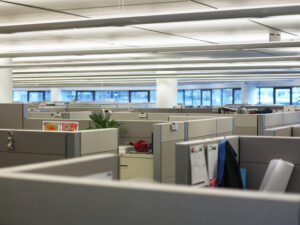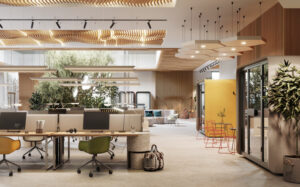Many traditional corporate offices feel cold and dull, with long rows of desks, blank walls, and fluorescent lighting failing to instill creativity or comfort. By contrast, coworking office design focuses on light, color, texture, and variety. It can create a welcoming environment that supports better thinking and stronger results.
As work habits daily workers change, the space around them too needs to evolve. The way a workplace looks and feels can affect productivity, creativity, and satisfaction. Whether it’s a quiet desk or a buzzing team table, space influences how well people work, and whether they want to return. Here’s how the design and aesthetics of a modern coworking spaces trumps the corporate bore of traditional offices.

The Enclosed Office Blueprint and Its Limits
Most traditional office space were designed around control and routine. Cubicles, closed doors, and assigned desks were once considered the most efficient setup. These layouts focused on managing people and processes with little attention to human experience.
However, more recent studies from Harvard Business Review and others show that rigid layouts lower engagement. When people are locked into a single setting, it can limit collaboration and reduce motivation. Uniform spaces don’t support different types of tasks. They also don’t give workers the autonomy they now expect, which may be all the more necessary for those striving for a work-life balance.
Today’s professionals want more variety, movement, and control over their physical surroundings. Static design fails to support the full range of modern work, especially for teams that need to focus, brainstorm, or rest throughout the day.

Key Features of Modern Coworking Space Design
Coworking spaces are designed for flexibility and well-being. They use plants, open ceilings, and sunlight to make the space feel fresh and energizing. The coworking space layout often includes lounge seating, private offices, phone booths, and collaborative zones.
One standout feature is variety. With a flexible workspace like coworking, members can move between quiet zones for deep work, collaborative spaces and meeting rooms for teamwork, and open spaces for hosting or networking. This mix supports productivity and keeps energy levels and creative juices flowing, encouraging a more productive overall routine.
Many spaces include dedicated desks for those who want consistency and private spaces for client calls or focused tasks. The goal of good coworking space design is to offer comfort, flexibility, and support all in one place.
The Benefits: Productivity and Wellbeing
Design directly affects performance. When people feel good in a space, they work better. Natural light, movement-friendly furniture, and quiet work areas improve focus and reduce stress. Biophilic design and flexible layouts help people concentrate and stay creative longer.
These features also reduce sick days and increase job satisfaction. Coworking members often report feeling more motivated and less isolated, especially when attending social events or networking events hosted by the space. The flexibility to move between private spaces, collaborative zones, and open areas supports both individual and team needs. People can adjust their surroundings to match their energy and task.
Design that supports movement, rest, and collaboration creates a healthier work culture. It helps teams stay sharp and individuals stay engaged, all while building a stronger sense of belonging.
Environmental Psychology in Modern Coworking Space Layout
Design has a real effect on how people feel. Ample natural light, green spaces with calm colors, soft textures, and acoustic control all help people stay relaxed and focused. Bright, noisy spaces can cause fatigue, while quiet, open rooms lift mood and help people think clearly.
Well-designed coworking spaces use these ideas to create environments that support all types of work. Small coworking spaces often do this particularly well, balancing community with calm. Layouts often include areas with ample natural light for concentration and movement, so people can change locations to match their tasks.
According to design psychology research, people working in spaces with variety and comfort report better focus and higher satisfaction. These spaces help remote professionals avoid burnout by giving them control and support within their day.
Why Corporate Offices Are Shifting Interior Design Strategies
The success of coworking hasn’t gone unnoticed. More companies are rethinking their office layouts to borrow ideas from coworking culture. The result? More open lounges, casual collaborative spaces, and better materials.
Corporate offices are adding more plants, artwork, and flexibility. They’re introducing hot-desking areas, adjustable lighting, and wellness rooms. This is especially important for remote workers who only come in occasionally. When they do, they want a space that works for them.
TIME and Space Matrix report that even in traditional sectors like finance and law, leaders are updating their real estate to appeal to younger talent and support hybrid work models.
Elements to Look for in a Well-Designed Coworking Space
Choosing the right coworking space means knowing what to look for.
Start with natural light. Is the space bright and inviting? Does it offer quiet zones where you can focus without distractions? Are the meeting rooms soundproof and well-equipped?
Look for variety. Can you switch between a dedicated desk, a lounge chair, and a standing table in one day? Are there clean and comfortable common areas?
The best coworking office design blends beauty and function. It should help you move, think, and connect with ease. Spaces that offer good air flow, noise control, and soft lighting support your health and mindset.
Pay attention to how the space feels when you walk in. Is it clean? Is it calm? Does it invite creativity? A good coworking space feels like a place you belong.
What makes coworking office design different from traditional corporate offices?
Coworking office design focuses on flexibility, comfort, and community. Unlike traditional corporate offices with uniform desks and enclosed offices, coworking spaces offer open workspaces, semi-private open areas, and modular furniture that support diverse working styles. From quiet zones and private offices to lounge areas and shared desks, coworking layouts use natural light, modern furniture, and movable partitions to create a more welcoming environment. The goal isn’t just to work, but to foster a professional environment that supports creativity, connection, and productive work environments.
How does workspace design affect productivity?
Coworking space design can significantly enhance performance and well-being. Key factors like ample natural light, ergonomic furniture, quiet areas, and balanced layouts help reduce stress and improve focus. In fact, coworking members often report fewer sick days and greater satisfaction compared to those in rigid corporate settings. Elements such as air quality, adjustable furniture, and access to green spaces or relaxation areas can create a more calming atmosphere, boosting mood and supporting a more productive work environment.
Is coworking design just about aesthetics?
Not at all. While modern interiors and natural materials contribute to a space’s visual appeal, coworking design is highly functional. Interior design choices- including modular furniture, temporary walls, and dedicated areas – are tailored to support focused work, community building, and collaborative zones. Whether you’re a remote worker, creative professional, or digital nomad, the space is designed to accommodate both private calls in quiet pods and networking events in shared spaces. A strong coworking space layout enhances productivity and encourages collaboration, not just visual harmony.
Can corporate offices adopt coworking design elements?
Yes. Many traditional offices are embracing elements from coworking office models to better support hybrid teams and modern work styles. This includes integrating flexible workspaces, collaborative spaces, phone booths for privacy, and open desks for shared use. Adding coffee shop-style lounges or dedicated desks with power outlets creates a more dynamic work environment. These changes make it easier for teams to adapt, connect, and thrive in both focused and collaborative settings.
What should I look for in a coworking space?
When choosing a coworking space, consider how well it supports your workflow and comfort. Look for a welcoming environment with natural light, quiet areas, enclosed offices or private spaces, and access to conference rooms or meeting rooms. If you’re attending networking events or hosting clients, ensure the event spaces are clean and professional. For daily work, spaces with modern amenities, ergonomic furniture, and dedicated desks or shared desks offer both variety and stability. Small coworking spaces might suit independent workers seeking calm, while larger ones often cater to coworking members interested in community building and collaboration.




